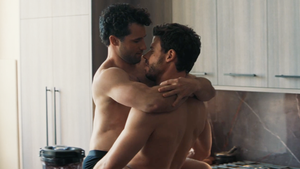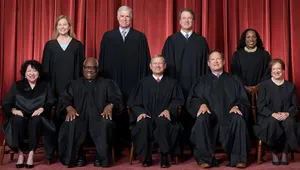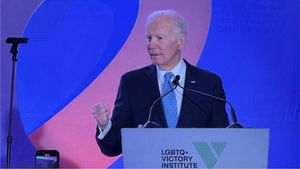Not so long ago, Greenwich Village seemed destined to reign eternal as the central neighborhood of New York City gay life. With a long counterculture history and as the collective-consciousness birthplace (courtesy 1969's Stonewall uprising) of international outness, the Village was a natural gay ground zero.
That is, until local rents soared and '80s and '90s gays forged north of 14th Street to recrown Chelsea as the queer habitat of choice, seemingly for the coming new millennium. That is, until local rents soared again, forcing the latest foray even further northward into the onetime NYC nether region of Hell's Kitchen, a pink surge that's earned the area a host of new nicknames, from Hellsea and NoChe (both nods to southern neighbor Chelsea) to Hell's Pantry and Hell's Kitchenette.
Running roughly from 34th to 57th Streets and from Eighth Avenue west to the Hudson River, Hell's Kitchen's proximity to Broadway and the Theatre District has meant stray gays have long lived here, attracted by the formerly cheap rents of its tenement-style housing. It's only in the past half decade that gay people have settled here en bloc, bringing with them the requisite bars and restaurants that now make Hellsea Gotham's hottest homo haunt.
Hell's Kitchen got its inauspicious start as a Hudson River-adjacent shantytown in the mid-1800s, serving as home to the countless Potato Famine-fleeing Irish immigrants who found work along the area's docks and rail lines. When the local population ballooned after the Civil War, tenements shot up and gang-style crime skyrocketed. It's during this period that a cop called Dutch Fred reportedly uttered the phrase that's most commonly credited with giving the area its name, in response to his partner who'd commented on the nabe's similarity to Satan's underworld kingdom. "Hell's a mild climate," Fred allegedly said. "This is Hell's Kitchen."
In the early 20th century, Prohibition only fueled the violence and racketeering in the neighborhood. The booming post-World War II economy brought relative calm and prosperity as a new wave of immigrants from Puerto Rico came to live and work alongside the Irish -- if not always entirely peacefully, as famously depicted on stage and screen in "West Side Story." In 1959, after two local children were killed in ethnic gang violence, community leaders rallied to change the area's moniker to Clinton, linking it to nearby De Witt Clinton Park. Though still sporadically used (mostly by developers and real estate hawkers), the name never stuck with residents.
Gangland crime returned to Hell's Kitchen (if it'd ever gone away) with a vengeance in the '70s with the rise of The Westies, a Gambino-linked Irish-American mob clan. Though mostly brought down by authorities in the mid '80s, their remnants purportedly linger, as heavily played upon in NBC's critically-acclaimed but short-lived early 2007 drama series "The Black Donnellys," now showing on HDnet and available on DVD.
Today, Hell's Kitchen is one of the most nationalistically diverse in the city, with Peruvians, Ecuadorians, Germans and Eastern Europeans among those who're represented strongly. The recent gay influx looks set not to replace this variety whole-hog as happened in Chelsea, but to coexist peacefully as just the latest element in a rich, feisty and sometimes downright devilish mix.
STAY
Until the much-anticipated opening of the Kimpton Group's $125 million 16-story Vu Hotel at 11th Avenue and 48th Street next spring, most of Hell's Kitchen's better hotels straddle the neighborhood's eastern border of Eighth Avenue, such as the 300-room Hampton Inn Manhattan Times Square North at 51st Street and the 400-room Belvedere at 48th. Neither is especially remarkable, but both get consistently high marks from travelers and offer solid accommodations with rates straddling the $200 mark; in other words, quite reasonable in a Manhattan market where the average hotel room runs $300 a night. For a bit more style and an address at the heart of 'hood, the cozy Hotel 414 has the further plus (or minus, depending on how much you want to mingle with fellow tourists) of being right along Restaurant Row. Book far ahead, as the 22 rooms fill quickly.
EAT
Though not yet known as one of New York's top restaurant neighborhoods, Hell's Kitchen is certainly on the culinary rise, and as mentioned is meanwhile home to the city's famed Restaurant Row on 46th Street between Eighth and Ninth Avenues. Although hopelessly tourist-laden, the strip includes some decent options (the Italian-cuisined Becco being among the most popular) that are undeniably convenient for a pre- or post-theatre dinner (though superior Italian can easily be had a few blocks further afield at ViceVersa, pleasing early-adapting refined local palettes for over eight years now). The gay incursion into the neighborhood has naturally brought shamelessly gay dining to the table, among the more popular (and fortunately better) of this ilk being the French-Asian HK and the Asian-Asian Bamboo 52. Thanks to its mix of mingling nationalities, Hell's Kitchen also offers a vast bounty of small under-the-radar dining options, many of which take part in the wonderful International Food Festival that commandeers Ninth Avenue between 37th and 57th Streets the weekend after Mother's Day every year.
PLAY
As the rising star -- some would already say the queen -- of mainstream New York gay nightlife, Hell's Kitchen is seriously cooking, with sleek bars like HK Lounge, Vlada and the veteran but still strong Therapy generating the most heat. A more casual and eclectic vibe can be found at the very popular Posh, while Latinos and their lovers will appreciate the dance and show palace Escuelita. Straight dance venue Pacha NYC on 46th Street is one of the city's coolest and most popular, and it often hosts gay (or at least mixed) nights. For a glimpse back in time to what pre-hype Hellsea gay life must've been like, check out the cheek at 9th Avenue Saloon.
DO
While it's literally just a stone's throw from such major Manhattan attractions as Times Square and the Theatre District as well as within easy walking distance of the shopping boon along Madison, Park and Fifth Avenues, Hell's Kitchen proper doesn't overflow with touristic activities all its own. Notable exceptions include the Hell's Kitchen Flea Market, held every Saturday and Sunday year round on 39th Street between Ninth and Tenth Avenues, and the esteemed Alvin Ailey Dance Theatre, which opened at Ninth Avenue and 55th Street in 2006. For TV fans there's a host of studios, including the CBS Broadcast Center, Unitel Studios (where Montel Williams tapes his daily talkfest), and the recording homes of Comedy Central faves The Daily Show with Jon Stewart and The Colbert Report. The Intrepid Sea-Air-Space Museum, unquestionably one of Hell's Kitchen's most enduring sightseeing attractions, is currently closed for renovations, but is set to reopen in Spring 2008, just in time to host its annual late May roster of events related to Fleet Week -- seven days that always make the local boys especially glad to live in Hellsea.











































































